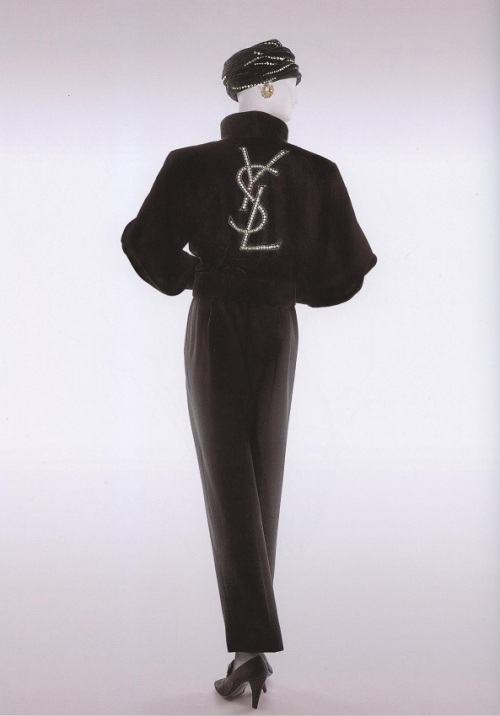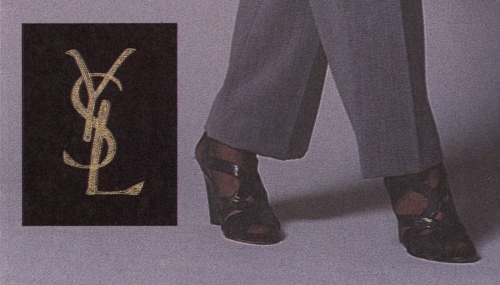Logos.
by Dustin
I’ve never been a big fan of logos on clothing, especially when they are blatantly plastered on an otherwise ordinary t-shirt or sweat top, however I am comfortable with a subtle embroidered monogram or insignia on a pocket or a button, or when logos are applied in an imaginative or an amusing way.
I’ve put together some patterns that utilize a logo or a monogram as a design feature and I had to ask myself “would I apply the logo if I were to make the garment from the pattern? Would I be trying to convince the world that it was a genuine designer garment?”.
If anyone asked I’d probably be proud to say that I’d made the garment from a vintage designer pattern and that I’d hand embroidered it myself to the pattern’s specifications. I think there’s a certain charm in that, and I’ll admit, I have actually done it.
For Christmas of 2011, I made my first nephew a pair of jeans from Vogue 2721, the Calvin Klein for kids jeans and skirt pattern, for his first Christmas at six months old. I made the jeans to be worn once he was a bit older, but the smallest size available is a 3, so to save having to wait until he was nearing three years old before he could wear the jeans I graded the size 3 down to a size 2 by using an Australian Standards childrens’ clothing measurements table. I used a light-weight dark indigo denim which I pre-washed for any possible shrinkage and also to eliminate any excess indigo dye. I used heavy beige top-stitching thread, especially to best show the Calvin Klein signature stitching on the back pockets!
Everyone loved the jeans, how could they not? They were so cute! My nephew is almost two years old now, and the jeans have been worn a few times already and they look great. And I must admit that whenever someone was told that I’d made them, I couldn’t help mentioning that “I made them from a vintage Calvin Klein for kids pattern from the early ‘80s”. I didn’t take any photos of the jeans when I made them or while they were being worn, but I’ll try to get some pictures the next time I’m at my Sister’s house and update this post with the pics.
Below is the Calvin Klein for kids jeans and skirt pattern 2721, which was available in size 3, 4, 5, 6, and 6x. It was also available as 2708 for girls in sizes 7, 8, 9, 10, 11, 12, 13, and 14. These two patterns were released in 1981 and featured in the May/June 1981 issue of Vogue Patterns magazine.
Shortly before 2721, Vogue pattern 2442, the pattern for jeans and skirt for women by Calvin Klein, was released in 1980 and featured in the March/April 1980 issue of Vogue Patterns magazine. The kids’ and womens’ patterns are practically the same styles but proportioned accordingly, and the kids’ jeans and skirt have an elasticized back waist.

Vogue’s 2442 had it’s own unique sizing chart which must have matched the sizing of the original Calvin Klein Jeans line. The Calvin Klein size 8 body measurements were equivalent to those of the Vogue Patterns regular size 12, so I suppose if you fit into a size 8 pair of Calvin Klein jeans then you would go and buy the size 8 Vogue pattern. Still, I’d bet that this created some confusion back in the day.
Below is one of the most famous advertising images from the 1980 Calvin Klein Jeans ad campaign featuring Brooke Shields as model, but below it is one from the 1979 ad campaign with Patti Hansen modelling. As the 1979 ad came out the year before Vogue pattern 2442 did, then it is more likely that we are seeing the same style of jeans on Patti as we are on the Vogue 2442 envelope, and the color of the denim and the stitching seems to be identical, as opposed to the jeans that Brooke Shields modelled which seem to be a lighter colored denim and a more beige or tan stitching.
Next is a Vogue pattern for men, 2798 by Pierre Cardin. This pattern for mens’ pyjamas and robe features the stylised Pierre Cardin ‘P’ logo on the chest pocket of the robe.
Vogue 2798 was released in the first half of the 1970s, I can’t say exactly when as I must not have that issue of the Vogue Pattern Book. Anyhow, the 1970’s was a time of mass expansion for, and worldwide licensing agreements made, by many fashion houses of the period, and probably most infamously by Cardin. His name and logo eventually appeared on not only clothing and accessories but almost any kind of object you can think of. Cardin was a very inventive Couturier of his day, most remembered for his ‘space age’ designs from the 1960’s, but he also designed some extremely elegant and unique clothes, particularly in the first decade of his career.
Now for the Valentinos…
Vogue released three patterns of Valentino designs in 1972 that feature an optional monogrammed ‘V’ on a breast pocket as a design feature. 2743 and 2746 featured in the Early Autumn 1972 issue (U.K.). and 2779 featured in the Autumn 1972 issue (U.K.).
The letter ‘V’ has been used as a graphic element in variations of Valentino’s logo over the decades, and also appeared in the form of hardware on belts, bags, and accessories, as a trim on clothing, and even subtly in the form of design lines in his clothing. A ‘v’ shaped waist seam was a common feature on many of Valentino’s designs from at least the 1960s to the 1980s.

The pocket pattern pieces for Vogue 2743, 2746 and 2759, and the pocket construction instructions for Vogue 2743. The embroidery method is a satin-stitch and it is the same for all three patterns. Notice how the style of the ‘V’ varies between the three?

This editorial photo of Valentino Garavani and two models wearing his designs was shot in the Valentino salon and was published in the March 1972 issue of Harper’s Bazaar magazine. The models are wearing short sleeved tops over blouses similar to those from patterns 2743, 2746 and 2779, only in more vibrant colors and without the monogrammed pockets.
Last, but not least, YSL!
Vogue 1836 by Yves Saint Laurent is a little different to the previous patterns as the embroidery motif is printed as an iron-on transfer. The heat-transfer ink was printed onto regular pattern tissue and a total of four transfers, including one test transfer, were included. When I first became aware of this pattern on the internet I assumed that a ready-made embroidered iron-on/fusible motif was included with the pattern, but since purchasing the pattern I have evidently discovered that was not the case. If I’d paid close attention to the list of required notions on the back envelope I would have realized that the logo had to be hand embroidered from a skein of embroidery floss. Below is a scan of the iron-on transfers.
Below: The instructions for 1836 include much more detailed and explicit directions for the application of the embroidery than the Valentino patterns do, which is very useful to someone like me who has never embroidered before. The recommended application method of the monogram is chain-stitch embroidery.

It is odd that the placement of the YSL motif is not determined on the pattern tissue, as I did check the tissue of the sleeve pattern and there are no placement lines oe marks, and that it is up to the sewer to decide on the placement. I would find this very irritating if I were to make the jacket.

Here is another example of the house of Yves Saint Laurent using its logo as a design feature, in this case it’s for an evening ensemble from the Fall/Winter 1984 Haute Couture collection, and the ‘YSL’ motif is embroidered with rhinestones and executed by Lanel.
Vogue 1836 was featured in the January/February 1987 issue of Vogue Patterns magazine, so it must have been designed by Yves Saint Laurent for 1986, about the same time that Karl Lagerfeld was emblazoning the number ‘5’ and double ‘C’s’ on anything and everything over at Chanel, making big designer logos fashionable. So we shouldn’t be surprised that this may have been happening at other fashion houses and that the trend even made its way into a Vogue designer sewing pattern. Here’s to hoping that anyone who made the jacket of 1836, and applied the transfer and embroidered the YSL motif, made it from a fabric and a level of skill worthy of bearing the YSL logo!

















I bet the little jeans you made are adorable – everything’s cuter in miniature! I look forward to seeing photos. =)
I’ve never been a huge fan of big logos either, but they aren’t too terrible on jean pockets. One of the more common things I’ve seen nowadays when you make your own jeans is to embroider your own name or initial on the back pockets (mirrored on the left) as sort of a self logo. And if they are made for someone else, it’s often the recipient’s name or initials. It’s fun because you can’t always see the letters in script at first glance, especially since you see the mirrored left pocket first.
I’ve been absent from blog-land for a while. I’m heading on over tonight to check out your latest posts.
Sewing the intitals of the wearer is very cute, especially when made for a friend or a child, and for a spouse or partner is ESPECIALLY cute! lol.
New posts are coming soon, including the photos of the Calvin Klein Kids jeans.
I’m also looking forward to seeing your nephew’s jeans.
And that Pierre Cardin pattern is so amazing. Have you seen Vogue 2574? It’s a 1971 Cardin pattern with a bull appliqué..
Hi Sarah,
I’m catching up on some LONG overdue replies to comments, with some new posts coming soon (including the Calvin Klein kids’ jeans). I have seen that Pierre Cardin pattern on ebay. Patterns like that with a novel detail like an applique always intrigue me, particularly 2474, perhaps because it’s a little kitsch and just a little strange!
Fascinating post, Dustin! I am actually quite surprised that designers would allow Vogue to include logos with their patterns.
Looking forward to seeing those baby jeans!
[…] Just for fun, I’ll close with this Pierre Cardin robe and pajamas, which included a logo appliqué: […]
How interesting. I had never thought of about logos included until you mentioned it. I really dislike the whole idea of logos – walking around advertising a “designer” is very 1980s flashy to me. But if I were trying for authenticity I guess I would consider it. I have the Calvin Klein Vogue 2442 because I like the shape of the jeans but I hadn’t realised the pocket is embroidered.